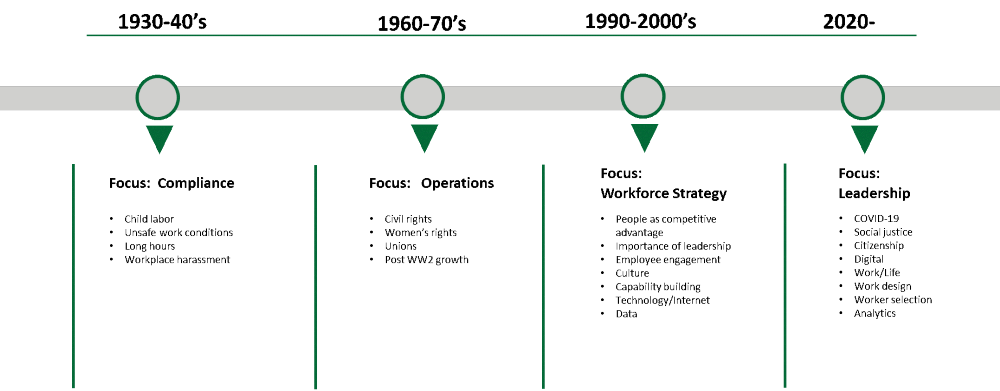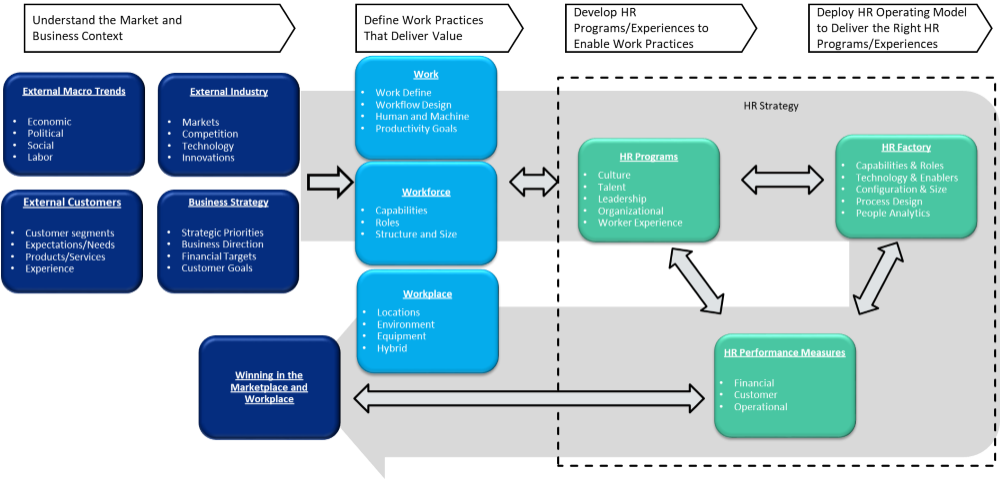Imperatives Through Exponential HR Impact | Deloitte US has been saved
By Art Mazor, Gary Johnsen, Amy Sanford, and Andrew Hill
According to Deloitte’s 2021 Human Capital Trends Special Report1, the pandemic strained and tested the worker-employer relationship. Employers were called upon to support workers’ health, livelihoods, and dignity to an unprecedented degree, and their success or failure to do so came under unprecedented scrutiny.
In this article, we are going to discuss, considering our times, the changing business expectations for HR, how HR can pivot to meet those challenges, and apply a five-step approach to effectively drive business imperatives through HR impact with meaningful investments in the right HR products, solutions, and services.
Setting the Context
There has never been a better time to be a human resource (HR) professional. For much of the history of HR, the function has responded to cultural, political, and/or organizational needs. Now, following an unprecedented global pandemic alongside shifts in public mindset around important challenges that include social justice and climate change, HR is in the spotlight to lead organizations in very new ways. Companies now are asking HR to lead from the front. The top issues for organizations today across diversity equity inclusion, hybrid working environments, virtual working spaces, digital collaboration, wellness, future of work, social citizenship, talent attraction and retention, personalized benefits, agile ways of working, equitable compensation strategies and worker experience, dominate the agenda of the C-suite. The workforce is at the center of these important issues and senior executives are turning to HR for practical counsel, strategies, and solutions.
Seventy-four percent of workers expect their organizations to be actively engaged in social issues.2 At the same time, 86% of respondents indicate that learning inflow of work is very important to building skills, yet few companies are equipped to do this,3 in late 2021, the Bureau of Labor Statistics report there are 10.4 million job openings in the United States4 and 50% of United States employees and 66% of United Kingdom employees want hybrid working conditions.5 On the surface, these statistics seem unrelated. In fact, together they reflect the wide range of disconnects in severe need of reconciliation and action—all related to the workforce of today and tomorrow. Broadly speaking, business leaders are uncertain in how to respond and address this wave of human needs coming into the workplace, and they face an array of parallel challenges to unlock innovation, compete with untraditional competitors, and meet ever-changing customer expectations. What to do about the workforce? Business leaders are turning to the CHRO for leadership. Is HR prepared to lead?
Historically, HR has responded to business needs by providing “personnel” administrative services, serving as guardians of employment brands, driving compliance with policies and regulations. This administrative and compliance response is still necessary; yet, no longer sufficient to address the work, workforce, and workplace dynamics facing organizations in a new era of consistent disruption. HR must pivot. Pivot to a new mindset as a leader within the organization, at the executive table, and in the boardroom. Such a pivot demands a new operating model that enables adaptable solutions with new ways of working informed by regularly sensing workforce, market, business, and workplace trends. Such sensing–much as leading consumer‑focused enterprises do to adapt their products–enables HR leaders to iteratively refine workforce solutions and experiences to elevate the human experience at work, embedding digital solutions to engage and enable productivity. Exponential HR organizations recognize the criticality of constant evolution to meet the nonstop pace of business today.6 This change starts with HR’s translating business imperatives into meaningful workforce strategies and shifts, leading organizations on all things to enable workforce purpose, meaning, well-being, and productivity in a world increasingly working in new physical, virtual, and hybrid workplace cultures that join humans with machines for collaboration in previously unimagined ways.
HR has pivoted before and will again. Reflecting on the evolution of the HR function, there are clear points of transition as business and marketplace dynamics have changed. At the dawn of the HR profession, in the 1930s–1940s, HR had to play a compliance role, focused then on the welfare of children, women, and others in the workplace. In the 1960s–1970s, businesses needed HR to mature their core operational processes of hiring, onboarding, training, and managing employee and organizational data. The third major transition was in the 1990s–2000s, when businesses recognized the competitive advantage of attracting, developing, and retaining the right talent. HR drove workforce programs that included competency modeling, performance management, succession planning. In all three transition phases, HR stood up and met the challenge. Once again, HR is at an inflection point. Arguably, the transition required here is a bigger leap than any before. The right decisions and investments in impactful interventions can deliver the workforce solutions and experiences to address today’s marketplace and workforce needs and position organizations to flex in a highly dynamic world.
Diagram 1

Defining HR Strategy
The word “strategy” is used to describe a lot of things and, fortunately, when appropriately defined and understood, can be a powerful outcomes driver. Meaningful HR strategy:
- Requires HR to have a deep understanding of the external market and the business strategy
- Is steered by a series of decisions/choices HR makes to help the business win in the marketplace and workplace
- Provides a North Star/guiding principles to determine HR priorities, policies, programs, services, HR capabilities, roles, size, structure, ways of working, enablers, and investments
- Focuses on solutions related to the work, workforce, and workplace centered around leadership capability, talent selection, engagement and development, organizational effectiveness, and effective HR service delivery
- Positions HR to continually sense external and internal trends, proactively adapt, respond to quickly shifting dynamics, elevate the human experience at work, and embed technology to augment humans, and enable productivity, and generate insights
- Incorporates a flexible governance framework and decision‑making process with measurable objectives to foster actions and behaviors required for enterprise success
- Follows a tangible road map of execution
Five-Step Process to Driving Business Imperatives through Exponential HR Impact
Creating Exponential HR Impact for an organization consists of five interdependent steps (see diagram 2):
Diagram 2

To keep reading, access the full PDF
Authors
References
- 12021 Global Human Capital Trends | Deloitte Insights
- 29 Work Trends That HR Leaders Can’t Ignore in 2021, Brian Kropp, Gartner, January 2021
- 3Learning in the Flow of Work Solutions: Market Primer, Mackenzie Wilson and Julie Hiipakka, Deloitte Research and Sensing, September 2019
- 4US Bureau of Labor Statistics, https://www.bls.gov/news.release/jolts.nr0.htm, October 2021
- 5retrieved https://www.gensler.com/gri/us-workplace-survey-2020-summer-fall, October 2021
- 6Exponential HR: Break Away from Traditional Operating Models to Achieve Work Outcomes, Arthur Mazor, Andrew Hill, Gary Johnsen, and Et al, Deloitte, 2019
Get in touch

Arthur H. Mazor
Art is Deloitte’s Global Human Capital Practice leader, leading the Global Human Capital Executive Team, and a member of the Global Consulting Offerings and Assets Leadership Team. Art is accountable for guiding the firm’s continued innovation and capability growth to drive unique and powerful client business outcomes that have positioned Deloitte as the world’s #1 Human Capital consultancy. Art brings his passion for enabling people to thrive through his collaboration with complex, global clients to unlock value by transforming the human experience and the very essence of work. Deloitte’s 12,000+ Human Capital practitioners around the globe bring pragmatic experience and research-backed solutions to pivot toward the future, seizing dynamic business, workforce, health, and digital disruptions. As a hands-on leader, Art is actively engaged in driving major transformation initiatives with some of the world’s best-known brands. He is a member of the firm’s team advancing Deloitte’s impact on Sustainability & Climate Change. Most recently, Art has served as Deloitte’s Global HR Transformation Practice leader, Human Capital Digital leader, and the global practice leader for Human Capital Strategy & Workforce Experience. With a professional journey of 26+ years focused on Human Capital Management, Art has held senior HR leadership, outsourcing executive, and human capital transformation consulting roles that form the multi-faceted foundation from which he delivers value to his clients across strategic planning, operating model and organization design, experience transformation, digital enablement, governance, and change management for sustained results. Art earned his degree in Organization & Management at Emory University's Goizueta Business School. Originally from New York and having worked and traveled around the world, today Art and his family reside in Atlanta.

